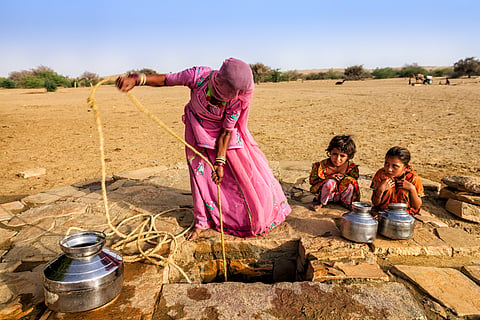

This year's unusual rainfall in Rajasthan has proven to be a boon for the state's languishing groundwater levels. Due to the excessive rainfall across the state, the groundwater levels have increased by about six metres in all districts. These figures have been revealed in the Post-Monsoon Assessment Report 2024 from the Rajasthan Groundwater Department.
According to the report, before the monsoon, groundwater was found at an average depth of 28.83 metres across the state. Now, it has improved to 23.01 metres. In other words, groundwater in Rajasthan has risen by 5.82 metres.
This preliminary report currently provides district-level data only. The department has stated that after analysing these figures, data will be provided for different zones. This will indicate how much groundwater has risen in each zone. After this analysis, it will also be possible to determine whether the groundwater levels have increased or decreased in the dark zones.
During this year's monsoon season, 27 out of the 50 districts in Rajasthan experienced abnormally high rainfall. In 15 districts, there was excessive rainfall, while eight districts received average rainfall. No district reported below-average or drought conditions.
Abnormal rainfall in Rajasthan means receiving 60 per cent or more rainfall than the normal average of 417.46 mm. According to the report, all districts, except Churu, saw a rise in groundwater levels. Despite receiving more than the normal rainfall, Churu district experienced a decrease of 0.19 metres in groundwater levels.
The highest increase in groundwater was recorded in Chittorgarh district, where it rose by 14 metres. This was followed by Sawai Madhopur (13.32 metres), Bundi (11.50 metres), Bhilwara (10.89 metres), Dungarpur (9.96 metres), Pratapgarh (9.96 metres), Alwar (9.87 metres), Baran (9 metres), Kota (8.23 metres), and Banswara (6.68 metres). In the state capital Jaipur, the groundwater level improved by 4.70 metres.
Surajbhan Singh, Chief Engineer of the Rajasthan Groundwater Department, told Down to Earth that the department has gathered groundwater data after the monsoon rains. These are preliminary figures, and further analysis is needed. The zonal data will be extracted from this analysis. After this, data regarding groundwater levels in the state's dark zones will also be available, though this will take a few months to complete.
This year, the western, desert regions of Rajasthan, including Bikaner, Barmer, Jaisalmer, and Jodhpur, also received abnormal rainfall—60 per cent or more than the usual amount. Jalore district recorded rainfall 20-59 per cent above average. Due to the increased rainfall, the groundwater level in Jaisalmer, which was at 49.79 metres before the monsoon, has decreased by 2.50 metres to 47.29 metres. In Barmer, the groundwater level increased by 1.73 metres, in Bikaner by 0.81 metres, and in Jodhpur by 1.51 metres. In Jalore, which received average rainfall, the groundwater level rose by 2.31 metres.
Down to Earth analysed the monsoon data released by the Rajasthan Water Resources Department. According to the analysis, the state received 63 per cent more rainfall than average from June 1 to October 1 this year. The highest rainfall in a district during the season was recorded in Karauli, with 1931 mm. On August 11, 2024, Karauli also saw the highest rainfall in a single day during the monsoon season. The groundwater level in Karauli, which was at 32.69 metres before the monsoon, rose by 6.20 metres to 26.49 metres by the end of the season.
Groundwater levels in Rajasthan have been in a worrying state. The state has 299 groundwater blocks, and due to excessive extraction and inadequate recharge, only 38 blocks (around 12 per cent) were deemed safe before the monsoon.
The remaining 88 per cent of the blocks are critical, semi-critical, or overexploited. Groundwater extraction has increased by 114 per cent over the last three decades. In 2023, Rajasthan’s groundwater extraction was at 149 per cent, up from 35 per cent in 1984.
These figures show the extent of groundwater exploitation in the state. However, department officials are optimistic that this year's increased rainfall could lead to some improvement in the groundwater levels, especially in some of the dark zones.
Rajasthan accounts for 10 per cent of India’s land area but has only about one per cent of the country’s water resources. According to the 2019 ‘Reassessment of Average Annual Per Capita Water Availability for 2021 and 2031’ report by the Central Water Commission, per capita water availability in India is estimated to be 1486 cubic metres in 2021 and 1367 cubic metres in 2031.
Water availability of less than 1,700 cubic metres is considered a water crisis, and less than 1,000 cubic metres is a water scarcity situation.
Rajasthan is far behind both of these thresholds. According to the 2009 Vyasa Committee report, the state has only 800 cubic metres of water available per person annually.
In Rajasthan, 87 per cent of drinking water comes from groundwater sources, including wells, borewells, and handpumps. In rural areas, these are the primary sources of drinking water. As the groundwater level drops, harmful minerals like salinity, total dissolved solids (TDS), nitrates, fluoride, sodium carbonate, zinc, lead, iron, and arsenic increase in the water, making it unsafe for consumption and harmful to health.
Experts say that 80 per cent of illnesses are caused by poor-quality water. According to a recent response in the Lok Sabha, 95 villages in 12 districts of Rajasthan are affected by dangerous levels of fluoride in drinking water, with approximately four million people suffering from fluorosis, the highest such number in the country.
Improved groundwater levels will ensure that people, especially in rural areas, have access to clean drinking water. This will reduce health-related issues and lower the amount of money spent on healthcare. As a result, families will have more savings and improved prosperity.